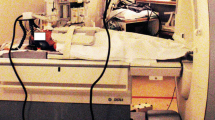Abstract
Subjects were imaged on a 1.5-T Signa MRI system using the head-neck vascular coil. An axial fast gradient echo cine, at the base of the second cervical vertebra, was obtained. A total of 128 images were acquired with a rapid image acquisition (one per second) over several respiratory cycles. The analog signal from the MR scanner (RF unblank) was utilized to determine the duration of the cine MR sequence. The phase of respiration was determined by analyzing the nasal air flow connected via pressure tubing to a pressure transducer outside the MR scanner room. We were thus able to determine the phase of respiration during acquisition of individual airway cine MR images. There was a wide range of airway volume measurements over the respiratory cycle with the lowest volume at end expiration and the highest at peak inspiration.


Similar content being viewed by others
References
Abbott MB, Dardzinski BJ, Donnelly LF (2003) Using volume segmentation of cine MR data to evaluate dynamic motion of the airway in pediatric patients. AJR 181:857–859
Donnelly LF, Shott SR, LaRose CR, et al (2004) Causes of persistent obstructive sleep apnea despite previous tonsillectomy and adenoidectomy in children with Down syndrome as depicted on static and dynamic cine MRI. AJR 183:175–181
Abbott MB, Donnelly LF, Dardzinski BJ, et al (2004) Obstructive sleep apnea: MR imaging volume segmentation analysis. Radiology 232:889–895
Larson AC, Kellman P, Arai A, et al (2005) Preliminary investigation of respiratory self-gating for free-breathing segmented cine MRI. Magn Reson Med 53:159–168
Schwab RJ, Pasirstein M, Pierson R, et al (2003) Identification of upper airway anatomic risk factors for obstructive sleep apnea with volumetric magnetic resonance imaging. Am J Respir Crit Care Med 168:522–530
Farag AA, Hassan H, Falk R, et al (2004) 3-D volume segmentation of MRA data sets using level sets: image processing and display. Acad Radiol 11:419–435
Solomon J, Warren K, Dombi E, et al (2004) Automated detection and volume measurement of plexiform neurofibromas in neurofibromatosis 1 using magnetic resonance imaging. Comput Med Imaging Graph 28:257–265
Hoffstein V, Zamel N, Phillipson EA (1984) Lung volume dependence of pharyngeal cross-sectional area in patients with obstructive sleep apnea. Am Rev Respir Dis 130:175–178
Arens R, Sin S, McDonough JM, et al (2005) Changes in upper airway size during tidal breathing in children with obstructive sleep apnea syndrome. Am J Respir Crit Care Med 171:1298–1304
Author information
Authors and Affiliations
Corresponding author
Rights and permissions
About this article
Cite this article
Kalra, M., Donnelly, L.F., McConnell, K. et al. Determination of respiratory phase during acquisition of airway cine MR images. Pediatr Radiol 36, 965–969 (2006). https://doi.org/10.1007/s00247-006-0241-z
Received:
Revised:
Accepted:
Published:
Issue Date:
DOI: https://doi.org/10.1007/s00247-006-0241-z




